Cookery Feature - Seafood For Christmas - and Beyond
For most of us Christmas is all about tradition and Darina Allen’s column this month focuses on the creating a memorable meal with roast turkey and all the trimmings. But new traditions can be created too and it’s great to see the visionary Galway chef and seafood advocate, JP McMahon, encouraging everyone to do just that by including Irish seafood in our festive dining this year.
In an initiative to celebrate the especially high quality of our winter seafood (thanks to the colder water) and encourage people to experiment with different fish, shellfish and seaweed during the Christmas period, JP is running seafood specials each weekend in December in Tartare Café + Wine Bar winner of our ‘Taste The Island’ Innovation Award 2020’, sponsored by Fáilte Ireland), and Cava Bodega (https://www.eatgalway.ie/)
In Tartare, there are small plates like Dooncastle Oyster, Sea Lettuce, Trout Roe and Crab, Chervil Mayonnaise, Potato Crisp - while in Cava they’re serving seafood tapas such as Scallops, Black Pudding, Cauliflower, Lardo, Pistachio and Wild Mussels, Almonds, White Wine, Garlic. (And the ever-evolving tasting menus at JP’s fine dining Aniar Restaurant always keep Irish seafood, shellfish and seaweed centre stage too). To try at home, you’ll find some of JP’s favourite seafood recipes from Tartare here until the end of December.
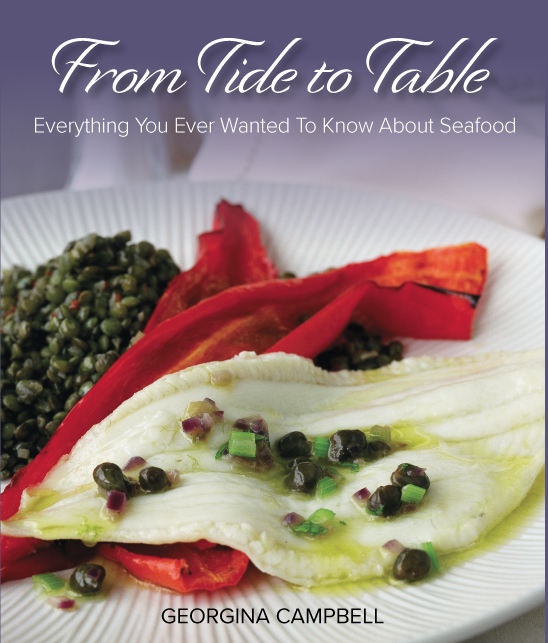 And, of course, on a more homely level our own recently published cookbook, From Tide To Table is choc-a-bloc with deliciously do-able fish and seafood recipes (including dozens of starters and light dishes), making this practical and inspiring cookbook the perfect kitchen companion for anyone who would like to include more seafood in their repertoire at Christmas – and at any time of year.
And, of course, on a more homely level our own recently published cookbook, From Tide To Table is choc-a-bloc with deliciously do-able fish and seafood recipes (including dozens of starters and light dishes), making this practical and inspiring cookbook the perfect kitchen companion for anyone who would like to include more seafood in their repertoire at Christmas – and at any time of year.
From Tide To Table, Everything You Ever Wanted to Know About Fish & Seafood, is available from bookshops & online
RECIPES (all taken from From Tide to Table):
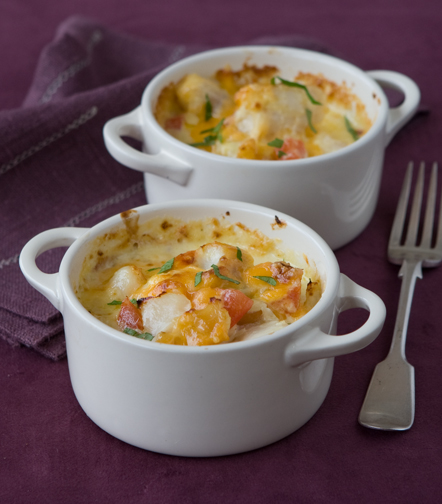 Smokies
Smokies
When a hot starter is called for, you really can’t beat this mouth-watering dish – which also makes a tasty light lunch or supper to serve with a side salad. Serves 4.
225g/8oz smoked haddock, cod or pollock (undyed if possible)
300ml/1/2 pint milk
a little finely chopped onion
pinch of freshly ground pepper
2 firm ripe tomatoes
300ml/1/2 pint cream
50g/2oz hard cheese, eg a mature red Cheddar, grated
chopped fresh flat-leaf parsley, to garnish
To Serve: freshly baked brown soda bread, or dillisk bread (see below)
Preheat the oven to 190ºC/375ºF/Gas 5. Put the smoked haddock into a pan with the milk and onion, season with pepper, then bring slowly to the boil. Remove the fish from the milk immediately. Discard the milk; skin the fish, remove any bones and break the flesh up into pieces.
Plunge the tomatoes briefly into boiling water to loosen the skins, then peel, scoop out and discard the seeds and chop the flesh. Divide half of the tomato between four ramekin dishes. Add the smoked haddock, then put the remaining tomato on top. Divide the cream among the dishes, scatter the grated cheese on top and bake for about 20 minutes until golden brown and bubbling. Garnish each dish with a little parsley and serve at once with freshly baked bread.
Dillisk Bread
This recipe came from one of Ireland’s most respected chefs, the late Gerry Galvin, who was well ahead of the curve with the use of seaweeds in Irish restaurants and served it at his famous west of Ireland fine dining destination, Drimcong House, in County Galway. The savoury flavour of the prolific Irish seaweed dillisk (aka dulse) defines this recipe but it has the natural sweetness of carrot too, making it a versatile bake that could even be served a tea bread. This bread is best eaten within two days.
Makes one 900g/2lb loaf
25g/1oz dried dillisk
100g/4oz butter, melted
1 large carrot, grated
4 eggs, lightly beaten
50g/2oz caster sugar
pinch of salt
250g/9oz plain white flour
1/2 tsp baking powder
Preheat the oven to 200C/400F/Gas 6. Soak the dillisk in a bowl of water for 5 minutes, then drain and pat dry with kitchen paper. Melt the butter in a small pan or in the microwave.
Brush the inside of a 900g/2lb loaf tin with a little of the melted butter. Place the remaining butter in a bowl with grated carrot, eggs, sugar, dillisk and salt. Mix lightly to combine.
Sift the flour and baking powder into a separate bowl and fold into the mixture butter and dillisk mixture. Transfer to the prepared loaf tin and smooth the top with a palette knife. Bake for 50 minutes, or until it is springy to the touch and a skewer inserted into the centre of the loaf comes out clean. Cool in the tin before turning out, then cut into slices to serve.
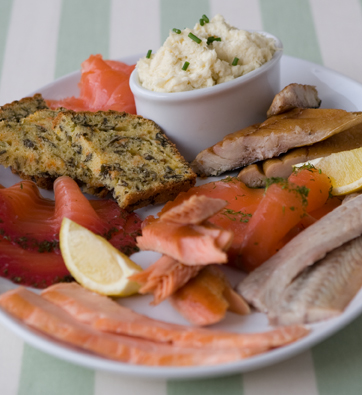 Brandade and Smoked Fish Platter
Brandade and Smoked Fish Platter
This is an interesting combination dish to serve at a party and, if time is short, it can be simplified by including more pre-prepared items. The time needed to soak the salted fish for the brandade will vary but, as a rule, an hour or two should suffice if only lightly salted, or up to a day if it is very dried out. Alternatively, it is very easy to make your own. Simply put a fillet of cod or ling in a plastic bowl and completely cover with a thick layer of salt. Chill for 24 hours. After a day most of the salt will have turned into brine because so much water has been drawn out of the fish, which will now be sufficiently preserved to keep for up to a week. Serves 4-6
75g/3oz beetroot gravadlax, thinly sliced (purchased, or use recipe given in From Tide To Table)
75g/3oz gravadlax, thinly sliced (purchased, or use recipe given in From Tide To Table)
75g/3oz smoked salmon slices
100g/4oz smoked trout fillet
100g/4oz smoked mackerel fillet, skin removed
50g/2oz smoked eel fillet
100g/4oz hot smoked salmon fillet
1/2 loaf dillisk bread, sliced (see above)
For the Brandade
100g/4oz salt ling or cod, soaked (see introduction notes)
120ml/4fl oz olive oil
120ml/4fl oz cream
2 garlic cloves, peeled
To Serve: snipped fresh chives lemon wedges
To prepare the brandade: In a small pan, poach the soaked ling or cod with a little water for about 10 minutes, then drain and roughly flake the flesh, removing all of the skin and bones.
Meanwhile, bring the olive oil and cream to the boil in a pan. Place the ling or cod and the garlic in a blender or food processor and turn on. Gradually pour in the hot oil and cream mixture to build up a thick emulsion. Transfer to a serving bowl and set on a large platter. Garnish with the chives.
To serve: Arrange the beetroot gravadlax and gravadlax beside the brandade, along with the smoked salmon, smoked trout, smoked mackerel, smoked eel and hot smoked salmon. Add slices of the dillisk bread and lemon wedges before serving.
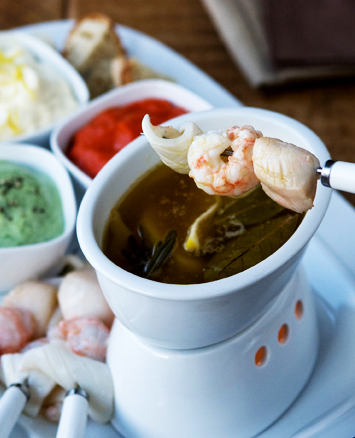 Seafood Fondue
Seafood Fondue
This is a fun way to eat seafood and a use for the fondue set that most of us have tucked away in the back of a cupboard - if not, funky fondue sets are available at reasonable prices and, although mainly intended for chocolate fondue, they are equally suitable for this recipe. As it cooks so quickly, fish is ideal for cooking at table - just scale up the quantities for a bigger party and experiment with your favourite selection of fish and seafood. Monkfish would work very well, as would salmon or tuna. Serves 4
12 prepared scallops
12 large raw peeled Dublin Bay prawns, preferably with veins removed
450g/1lb prepared squid, cut into bite-sized diamond pieces
For the Marinade
150ml/1/4 pint olive oil
150ml/1/4 pint white wine
2 garlic cloves, crushed
1 slice lemon, halved
2 bay leaves
1 fresh rosemary sprig
salt and freshly ground black pepper
To Serve: basil mayonnaise; lemon and dill mayonnaise; red pepper and chilli relish (see below)
To prepare the marinade, place the olive oil in a non-metallic bowl and stir in the wine, garlic, lemon, bay leaves and rosemary. Season to taste. Add the prepared seafood and set aside for 30 minutes to allow the flavours to develop.
Remove the seafood from the marinade with a slotted spoon and then thread a scallop, prawn and piece of squid onto each 10cm/4 inch wooden skewer. Arrange on a plate until needed - you should have 12 skewers in total.
Transfer the marinade to the fondue pan and simmer gently for 2 minutes, stirring frequently. Set the pan over the fondue burner at the table. Serve with the plate of prepared seafood for dipping and have bowls of the basil mayonnaise, lemon and dill mayonnaise and red pepper and chilli relish so that guests can help themselves.
Mayonnaise
This quick mayonnaise is made in a food processor and it will keep well in the fridge for up to one week. It only takes minutes to make and is far better than shop bought alternatives. Makes 300ml/1/2 Pint .
1 egg, at room temperature
2 tsp white wine vinegar
1/2 tsp salt
pinch of caster sugar
1 tsp Dijon mustard
120ml/4fl oz olive oil
120ml/4fl oz sunflower oil
Break the egg into the food processor and add the vinegar, salt, sugar, mustard and half of the olive oil. Secure the lid and whizz for 10 seconds. Leave to stand for a couple of seconds, then turn on again at medium speed and pour the remaining olive oil and sunflower oil through the feeder tube in a thin steady stream. This should take 25-30 seconds. Switch off the machine, take off the lid, scrape down the sides, and whizz again for 2-3 seconds. Transfer to a bowl or a jar, season to taste and cover with clingfilm. Chill until ready to use.
Variations: Lemon and Dill - stir the finely grated rind of 1 lemon and 2 tablespoons of chopped fresh dill into the mayonnaise; Basil - add a good handful of fresh basil leaves to the food processor with the egg and continue to make as described above.
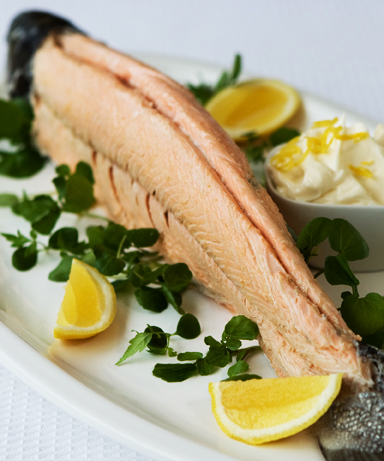 Whole Poached Salmon
Whole Poached Salmon
Salmon and celebrations tend to go hand in hand and no buffet table is complete without a magnificent dressed whole salmon as the centrepiece. This method of cooking salmon produces a moist perfectly cooked fish every time. The larger the fish the more liquid required and, therefore, the longer the liquid takes to heat up and cool down again. Any leftovers can be used in sandwiches. Sea trout can be used instead of the salmon when available, and an easy alternative hot salmon dish (to prepare ahead and cook at the last minutes) is Salmon Kiev – the recipe is given in From Tide To Table. Serves at least 8.
1.8kg/4lb salmon, gutted, scaled and cleaned (gills removed)
150ml/1/4 pint dry white wine
2 bay leaves
few slices lemon
1 small onion, sliced
few fresh parsley sprigs
few black peppercorns
1 stuffed olive, halved (optional)
salt and freshly ground black pepper
watercress sprigs and lemon wedges, to garnish
To Serve: lemon and dill mayonnaise (Stir the finely grated rind of 1 lemon and 2 tablespoons of chopped fresh dill into ½ pint/300ml mayonnaise).
Wash the salmon well under cold running water. Remove the head and tail if wished. To poach, place the salmon in a fish kettle. Pour over the white wine and just enough water to cover the fish. Add the bay leaves, lemon, onion, parsley and peppercorns. Cover the fish kettle with a lid. Bring the liquid slowly to the boil and simmer for 2 minutes. Turn off the heat and leave the salmon (still covered) in the liquid until it is quite cold.
When the salmon is completely cold, carefully remove the skin. Scrape away any brown flesh to reveal the pink underneath. If the head and tail are still on, remove the eyes, if liked, and fill the sockets with half a stuffed olive or fresh herb sprigs. Cut a 'v’ shape in the tail to neaten it. Cover and chill for at least 30 minutes.
Place the salmon on a large serving platter and garnish with watercress sprigs and lemon wedges to serve. Accompany with the lemon and dill mayonnaise.
VARIATION: Baked Whole Salmon
Place the salmon on a large piece of buttered foil and pour over the wine. Scatter the bay leaves, lemon, onion, parsley and peppercorns on top. Fold the foil loosely over the fish to enclose completely. Bake at 190ºC/375ºF/Gas 5 for 10 minutes per 450g/1lb until cooked through.





There are currently no comments
Leave a comment
Not a member? Register for your free membership now!
Or leave a comment by logging in with: